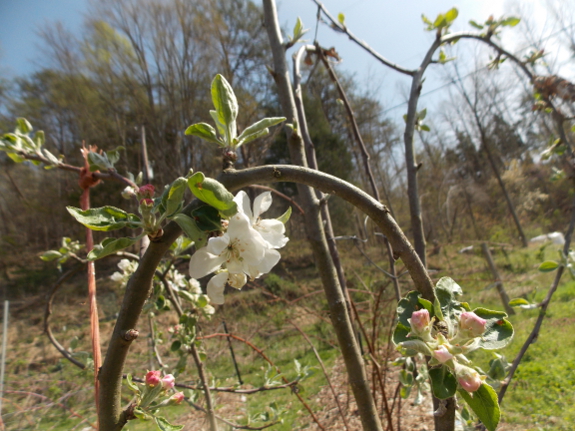
Late-blooming apple varieties

We got Mom two dwarf
apple trees a year ago --- an Early Transparent and a Cox's Orange
Pippin. They've already paid for themselves, in my opinion,
because Mom's close observation opened my eyes to a characteristic I
should have been thinking about when choosing fruit tree varieties ---
bloom time. During that hard freeze
a couple of weeks ago, Mom noted that her Early Transparent hadn't
started blooming yet, so its flowers weren't impacted. With my
mother's observation fresh on my mind, I noticed that my own Early
Transparents were also late bloomers that might have missed the worst of
the freeze.
Suddenly, I understand why Early Transparent is probably the most common apple variety planted in our area. The tree stands up to cedar apple rust
and is also less likely to be nipped by our (quite common) late spring
freezes. In case you're in the market for a late-blooming apple,
other choices include Arkansas Black, Bedan, Belmac, CrimsonCrisp, Gala,
Golden Delicious, GoldRush, Haraldred, Honeycrisp, Indian Summer Crab,
King, Melrose, Michelin, Nittany, Northern Spy, Northwest Greening,
Queen Cox, Ramey York, Red Boskoop, Red Rome, Red Yorking, Rome Beauty,
Sweet Sixteen, Winter Banana, Winesap, Wise, and Wolf River.
By the way, isn't it cool how my loops turned an eight-year-old non-blooming dwarf apple into a tree loaded with flowers in one season? Now I just have to wait and see if any of them survived the freeze and turn into fruits.
Want more in-depth information? Browse through our books.
Or explore more posts by date or by subject.
About us: Anna Hess and Mark Hamilton spent over a decade living self-sufficiently in the mountains of Virginia before moving north to start over from scratch in the foothills of Ohio. They've experimented with permaculture, no-till gardening, trailersteading, home-based microbusinesses and much more, writing about their adventures in both blogs and books.
Want to be notified when new comments are posted on this page? Click on the RSS button after you add a comment to subscribe to the comment feed, or simply check the box beside "email replies to me" while writing your comment.

We live in northern Arizona at about 4500' altitude and usually experience a weather cycle like you described, warm enough in February to start blossoms then freezing weather in April. Very few people here try to have fruit trees for that reason. Late blooming types could be part of a solution. Training the branches down might make it possible to protect the young fruit in April with some sort of row cover material. It might also make it easier to prevent bird damage later on. Thank you for the blog. I'm looking forward to trying some of these ideas in the next year or so.
Dave C.
I too have property at 4500 ft elevation in Peeples Valley, AZ. In 2015 and 2016 I experienced 100% loss of buds on a variety of apples, peaches, nectarines, pears, and almonds. Most of the varieties were 700 to 800 chill hours. In 2016 we had about two weeks of mid 70 F degree temperatures and a heavy bud set appeared and matured through the less warm days in March. Unfortunately, in late March and mid April we had a few hard freezes and bitter disappointment.
Is there more information on late blooming apple or other cultivar varieties?
Thank you, Chris
Looks like all the Northern Arizona folks are all in the same boat. Some of the comments are from 2015. Have you had success with any of the techniques mentioned here? I’ve got 10 acres of flat land. I’ve got a honey crisp and a Granny Smith who are about 6 years old and an apple tree I grew from seed that’s 5 and producing fruit. It’s not bad either. I was also thinking that maybe growing full size trees and letting them get big might help since cold sinks. Maybe the height would help protect the blooms. It’s so frustrating. I will be trying some late blooming varieties but was hoping some of the previous posters would follow up on their success or failures. Thanks.